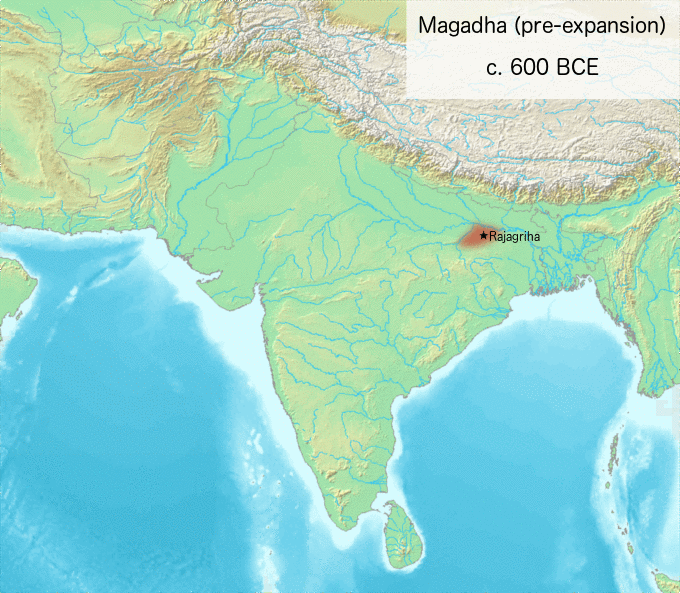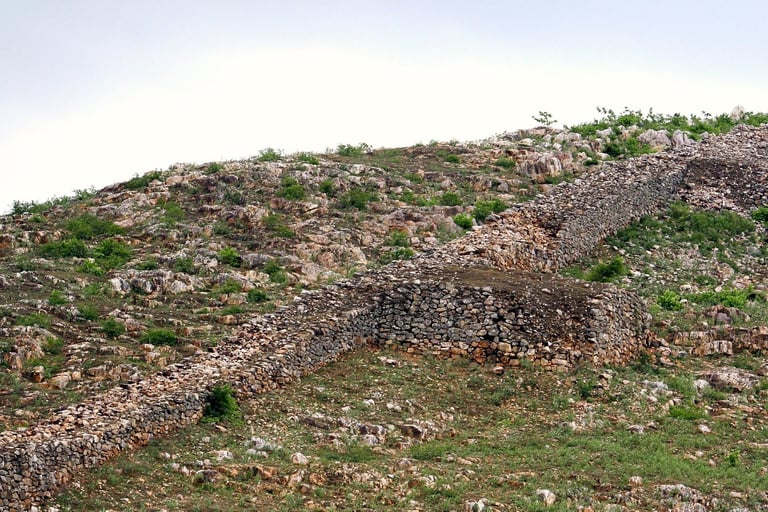
The Magadha Empire: Ancient India's Foundation Kingdom That Shaped Civilization
Complete guide to Magadha Empire: three dynasties, influential rulers, Buddhist connections, and how this ancient Indian kingdom shaped the Maurya Empire.
HISTORYINDIAN HISTORYEMPIRES/HISTORY
Keshav Jha
8/9/202511 min read


The Magadha Empire stands as one of ancient India's most influential and enduring kingdoms, establishing the foundation for what would become the subcontinent's first major imperial dynasties. Located in present-day Bihar and eastern India, this powerful kingdom emerged as a dominant force during the 6th century BCE and continued to shape Indian politics, culture, and religion for over two centuries.
What Was the Magadha Empire?
The Magadha Empire was an ancient Indian kingdom that ruled from approximately 544 BCE to 320 BCE, encompassing three successive dynasties: the Haryanka, Shishunaga, and Nanda dynasties. Magadha was a region and kingdom in ancient India, based in the eastern Ganges Plain. It was one of the sixteen Mahajanapadas during the Second Urbanization period. The empire's strategic location in the fertile Gangetic plains, combined with its natural defenses and ambitious rulers, enabled it to become the first unified political entity to control vast territories across northern and eastern India.
The kingdom's significance extends far beyond its political achievements. Magadha played an important role in the development of Jainism and Buddhism and formed the core of the Maurya Empire, making it instrumental in shaping India's spiritual and cultural landscape for millennia to come.
Geographic Location and Strategic Advantages
Magadha was an ancient kingdom of India, situated in what is now west-central Bihar state, in northeastern India. The empire's geographic boundaries were carefully defined by natural features that provided both strategic advantages and natural defenses. The territory of the Magadha kingdom proper before its expansion was bounded to the north, west, and east, respectively, by the Gaṅgā, Son, and Campā rivers and the eastern spurs of the surrounding hills.
This strategic positioning offered several critical advantages that contributed to Magadha's rise to prominence. The fertile alluvial soil of the Gangetic plains supported intensive agriculture, generating the agricultural surplus necessary to maintain large armies and administrative structures. The river systems provided excellent transportation networks for trade and military campaigns, while the surrounding hills and water barriers created natural defensive positions that protected the kingdom from external threats.


The Three Great Dynasties of Magadha
The Haryanka Dynasty: Foundations of Power (544-413 BCE)
The Haryanka dynasty established Magadha as a major power under the leadership of visionary rulers who understood the importance of strategic expansion and diplomatic alliances. They were the first dynasty to rule Magadha, with its capital at Rajagriha.
Bimbisara: The Empire Builder (544-492 BCE)
Bimbisara (558 BC – 491 BC) was the son of Bhattiya. According to Buddhist chronicles, Bimbisara ruled for 52 years (544 BCE – 492 BCE). Bimbisara represents the archetypal example of an effective ancient Indian ruler who combined military prowess with diplomatic acumen. A contemporary and follower of the Buddha. He was also said to be an admirer of Mahavira, who was also his contemporary.
Bimbisara's reign marked the beginning of Magadha's systematic expansion through a combination of conquest, marriage alliances, and diplomatic negotiations. His capital city, which had his capital at Girivraja/Rajagriha (Rajgir), became a center of political power and religious learning that attracted scholars, merchants, and spiritual leaders from across the subcontinent.
Ajatashatru: The Consolidator (492-460 BCE)
Following Bimbisara's death, his son Ajatashatru continued the expansionist policies that had made Magadha dominant in the region. He was succeeded by his son Ajatashatru (492—60 BC). Ajatashatru's reign was characterized by successful military campaigns against neighboring kingdoms and the consolidation of Magadhan power across the Gangetic plains.
According to historian John Keay, a proponent of the "Long Chronology," Bimbisara must have been reigning in the late 5th century BCE and Ajatashatru in the early 4th century BCE. This chronological framework helps modern historians understand the broader context of Magadha's development during this crucial period of Indian history.
The Shishunaga Dynasty: Transition and Growth (413-345 BCE)
The Shishunaga dynasty represented a period of transition and continued expansion for the Magadhan Empire. While less is known about the specific rulers and their achievements compared to their predecessors and successors, this dynasty maintained the kingdom's territorial integrity and continued its gradual expansion across northern India.
The Nanda Dynasty: Peak of Power (345-320 BCE)
The Nanda dynasty marked the culmination of Magadhan power and territorial expansion. The Nanda dynasty was founded by Mahapadma Nanda. He is said to have established the dynasty by overthrowing the last ruler of the Shishunaga dynasty, which ruled Magadha before the Nandas.
Mahapadma Nanda: The Great Conqueror
Mahapadma Nanda usurped the throne by murdering the last king of the Shishunaga dynasty. Despite the violent nature of his ascension to power, Mahapadma Nanda proved to be an exceptionally capable ruler who expanded Magadhan territory to unprecedented levels. His military campaigns extended Magadhan influence across much of northern and central India, creating the largest unified political entity the subcontinent had yet seen.
The Buddhist, Jain, and Puranic traditions all state that there were 9 Nanda kings, but the sources differ regarding the specific details of their individual reigns and achievements. However, archaeological and textual evidence confirms that the Nanda period represented the height of pre-Mauryan political organization in ancient India.
Cultural & Religious Impact
The Magadha Empire's influence extended far beyond political and military achievements to encompass profound cultural and religious transformations that continue to shape Indian civilization today.
Buddhism and Jainism Development
Regarding the prevalent religion, it is confirmed from the epical sources that Brahmanism and Buddhism were the two main religions that prevailed during the Pradyota period. The Magadhan rulers' patronage of both traditional Brahmanical practices and emerging religious movements created an environment of theological diversity and intellectual ferment.
The empire's association with Buddhism proved particularly significant for world history. Contemporary and a follower of the Buddha, Bimbisara describes his relationship with the Buddhist founder, establishing a precedent for royal patronage that would continue through subsequent dynasties. This royal support provided Buddhism with the institutional backing necessary for its eventual spread across Asia.
Capital Cities as Cultural Centers
Its capitals, Rajagriha and Pataliputra, were hubs of culture, politics, and learning, leaving lasting impacts on Indian intellectual and artistic development. These urban centers attracted scholars, artists, merchants, and religious teachers from across the known world, creating cosmopolitan environments that fostered innovation and cultural exchange.


Military and Administrative Innovations
The success of the Magadha Empire stemmed not only from the personal capabilities of its rulers but also from systematic innovations in military organization and administrative structure that set new standards for governance in ancient India.
Strategic Military Advantages
It was surrounded by five hills, the openings in which were closed by stone walls on all sides, which made it impregnable. This description of Rajagriha illustrates the sophisticated defensive strategies employed by Magadhan rulers. The combination of natural barriers and constructed fortifications created defensive positions that could withstand prolonged sieges and deter potential invaders.
Administrative Excellence
The credit for the rise of the Magadha Empire goes to the competent rulers of the Magadha Kingdom. Shishunaga, Bimbisara, Ajatasatru, Mahapadma, and Chandragupta were exceptionally able kings. The consistent quality of leadership across multiple dynasties suggests the development of effective governmental institutions and administrative practices that transcended individual rulers.
They were fortunate in having great ministers and diplomats like Vassakara, Kautilya, and Radha Gupta, without whose efforts Magadhan ascendancy would have suffered. This emphasis on capable administrative personnel indicates that the Magadhan system recognized the importance of professional competence in government service, establishing precedents that would influence later imperial administrations.
Economic Foundations and Trade Networks
The Magadha Empire's sustained expansion and political dominance required substantial economic resources that were generated through agricultural productivity, trade networks, and resource extraction from conquered territories.
The fertile Gangetic plains provided the agricultural foundation necessary to support large urban populations and maintain professional armies. The empire's strategic location along major river systems facilitated both internal commerce and long-distance trade connections that brought wealth and exotic goods from across the subcontinent and beyond.
Archaeological evidence suggests that Magadhan cities served as important commercial centers where goods from diverse regions were collected, processed, and redistributed. This commercial activity generated the tax revenues that funded military campaigns, urban construction projects, and the elaborate court culture that attracted talented individuals from across the ancient world.
Legacy and Historical Significance
Magadha is a 'Great Kingdom' of ancient India, and it spawned two powerful Indian empires—the Maurya Empire and the Gupta Empire. This assessment accurately captures the empire's most significant historical contribution: establishing the political, administrative, and cultural foundations upon which India's greatest imperial dynasties would build.
Foundation for Future Empires
The Magadha Empire's institutional innovations, territorial integration, and cultural synthesis created the template that subsequent rulers would adapt and expand. formed the core of the Maurya Empire (c. 320–185 BCE), demonstrates the direct continuity between Magadhan achievements and later imperial developments.
Influence on Indian Political Thought
The Magadhan period witnessed the development of sophisticated political theories and administrative practices that would influence Indian governance for centuries. The empire's success in managing diverse populations, integrating conquered territories, and maintaining stability across vast distances provided practical lessons that informed later political theorists and administrators.
Modern Archaeological Insights
Recent archaeological research has provided new insights into the material culture and urban development of the Magadhan period, though specific major discoveries related to Magadha in 2024-2025 have not been prominently reported in current archaeological literature. However, ongoing excavations at sites like Rajgir and Patna continue to yield artifacts and architectural remains that enhance our understanding of this crucial period in Indian history.
The application of modern dating techniques and analytical methods to previously discovered artifacts has refined our chronological understanding of Magadhan development and provided more precise information about the empire's economic activities, trade relationships, and technological capabilities.


Frequently Asked Questions
Q: When did the Magadha Empire exist, and what was its timeline?
The Magadha Empire existed from approximately 684 BCE to 320 BCE, though most historical scholarship focuses on the period from 544 BCE to 320 BCE, when the empire achieved its greatest territorial extent and political influence. The empire encompassed three successive dynasties: the Haryanka dynasty (544-413 BCE), the Shishunaga dynasty (413-345 BCE), and the Nanda dynasty (345-320 BCE). This chronological framework represents over two centuries of continuous political development that laid the foundation for subsequent Indian imperial traditions.
Q: Who were the most important rulers of the Magadha Empire?
The most significant rulers of Magadha include Bimbisara and Ajatashatru from the Haryanka dynasty, along with Mahapadma Nanda from the Nanda dynasty. Bimbisara (544-492 BCE) established the empire's expansionist policies through strategic marriages and diplomatic alliances, while his son Ajatashatru (492-460 BCE) consolidated these gains through military conquest. Mahapadma Nanda founded the final dynasty and expanded Magadhan territory to its greatest extent, creating the largest unified political entity in pre-Mauryan India. These rulers demonstrated exceptional administrative capabilities and military acumen that enabled sustained territorial expansion.
Q: What geographical advantages made Magadha successful compared to other ancient Indian kingdoms?
Magadha's strategic location in the fertile Gangetic plains provided several critical advantages that distinguished it from contemporary kingdoms. The territory was naturally protected by the Ganges, Son, and Campa rivers, along with surrounding hills that created defensive barriers against invasion. The rich alluvial soil supported intensive agriculture, generating the economic surplus necessary to maintain large armies and administrative structures. Additionally, the extensive river network facilitated trade and military movement, while the region's mineral resources, including iron deposits, supported advanced metallurgy and weapon production.
Q: How did the Magadha Empire influence the development of Buddhism and Jainism?
The Magadha Empire played a crucial role in the early development and spread of both Buddhism and Jainism through royal patronage and institutional support. King Bimbisara was both a contemporary and follower of the Buddha while also maintaining admiration for Mahavira, the founder of Jainism. This royal endorsement provided these emerging religious movements with the social legitimacy and material resources necessary for their growth. The empire's capital cities became centers of religious learning and debate, attracting scholars and practitioners from across the subcontinent and facilitating the intellectual development of these traditions.
Q: What led to the end of the Magadha Empire and its transformation?
The Magadha Empire transitioned into the Maurya Empire around 320 BCE through a political revolution led by Chandragupta Maurya and his advisor Kautilya (also known as Chanakya). They successfully overthrew Dhana Nanda, the last ruler of the Nanda dynasty, through a combination of military strategy and popular support. Rather than representing a complete break with the past, this transition preserved and expanded upon Magadhan administrative innovations and territorial control, ultimately creating an even larger empire that encompassed most of the Indian subcontinent.
Q: Where were the capital cities of Magadha located, and what was their significance?
The Magadha Empire maintained two major capital cities that served as centers of political power and cultural development. Rajagriha (modern Rajgir in Bihar) served as the primary capital during the early Haryanka period and was strategically located among five hills with fortified stone walls, making it virtually impregnable. Later, Pataliputra (modern Patna) gained prominence, particularly during the Nanda period, due to its advantageous position at the confluence of major rivers. Both cities functioned as hubs of culture, politics, and learning, attracting merchants, scholars, and religious teachers from across the ancient world.
Q: What archaeological evidence supports our understanding of the Magadha Empire?
Archaeological excavations at key Magadhan sites have uncovered substantial material evidence that corroborates historical accounts found in Buddhist, Jain, and Brahmanical texts. Excavations at Rajgir have revealed extensive fortification systems, including the famous cyclopean walls that protected the ancient capital. Archaeological work at Patna has uncovered urban structures, sophisticated drainage systems, and artifacts indicating advanced craft production. Additionally, discoveries of coins, pottery, iron tools, and luxury goods provide insights into the empire's economic activities, trade networks, and technological capabilities during this formative period of Indian history.
Q: How did Magadha's military and administrative innovations contribute to its success?
The Magadha Empire developed sophisticated military and administrative systems that set new standards for governance in ancient India. The empire's military advantage stemmed from its access to iron ore deposits, which enabled the production of superior weapons and tools. Administratively, Magadha benefited from consistently capable leadership and the development of professional bureaucratic institutions that transcended individual rulers. The empire employed skilled ministers and diplomats who implemented effective policies for territorial integration and resource management. These innovations in statecraft provided the foundation for the administrative systems that would later characterize the Maurya and Gupta empires.
Q: What was the economic foundation of the Magadha Empire's power?
The economic strength of the Magadha Empire rested on multiple foundations that enabled sustained expansion and political dominance. Agricultural productivity in the fertile Gangetic plains generated the surplus necessary to support large urban populations and professional armies. The empire's strategic position along major river systems facilitated both internal commerce and long-distance trade connections, bringing wealth from across the subcontinent. Additionally, control over mineral resources, particularly iron deposits, supported advanced metallurgy and provided valuable trade commodities. The empire's cities served as commercial centers where goods from diverse regions were collected, processed, and redistributed, generating substantial tax revenues.
Q: What is the lasting historical significance of the Magadha Empire?
The Magadha Empire established fundamental precedents for political organization, cultural synthesis, and imperial administration that influenced Indian civilization for centuries. The empire created the template for large-scale territorial integration while respecting local traditions and practices, a model that subsequent dynasties would adapt and expand. Magadha's patronage of diverse religious traditions established principles of tolerance that became characteristic of Indian political culture. Most significantly, the empire formed the direct foundation for the Maurya Empire, which would become one of the largest and most influential empires in ancient history, spreading Indian cultural and religious traditions across much of Asia.
The Magadha Empire represents a pivotal transformation in ancient Indian history, marking the transition from smaller regional kingdoms to unified imperial administration that would characterize the subcontinent's political development for the next millennium. The formation of the largest state in India during this period was the work of several enterprising and ambitious rulers who recognized that effective governance required more than military conquest.
The empire's achievements in political organization, cultural patronage, and territorial integration established precedents that influenced not only immediate successors like the Maurya Empire but also later dynasties throughout Indian history. The Magadhan synthesis of diverse cultural traditions, administrative innovations, and economic strategies created a template for imperial governance that proved remarkably durable and adaptable.
Modern India's federal structure, cultural diversity, and emphasis on religious tolerance can trace their conceptual origins to the Magadhan experiment in managing large-scale political entities while respecting local traditions and practices. The empire's legacy thus extends far beyond its chronological boundaries to influence contemporary discussions about governance, cultural identity, and national integration.
Understanding the Magadha Empire provides essential insights into the foundational period of Indian civilization when the basic patterns of political organization, cultural synthesis, and economic development were established. For students of ancient history, political science, and cultural studies, the Magadhan experience offers valuable lessons about the challenges and opportunities involved in creating and maintaining complex political entities in diverse cultural environments.
The empire's story demonstrates that successful political institutions must balance central authority with local autonomy, integrate military power with diplomatic skill, and combine economic efficiency with cultural patronage. These lessons remain relevant for understanding not only ancient Indian history but also the broader patterns of political development that have shaped human civilization throughout the ages.
Subscribe To Our Newsletter
All © Copyright reserved by Accessible-Learning Hub
| Terms & Conditions
Knowledge is power. Learn with Us. 📚


